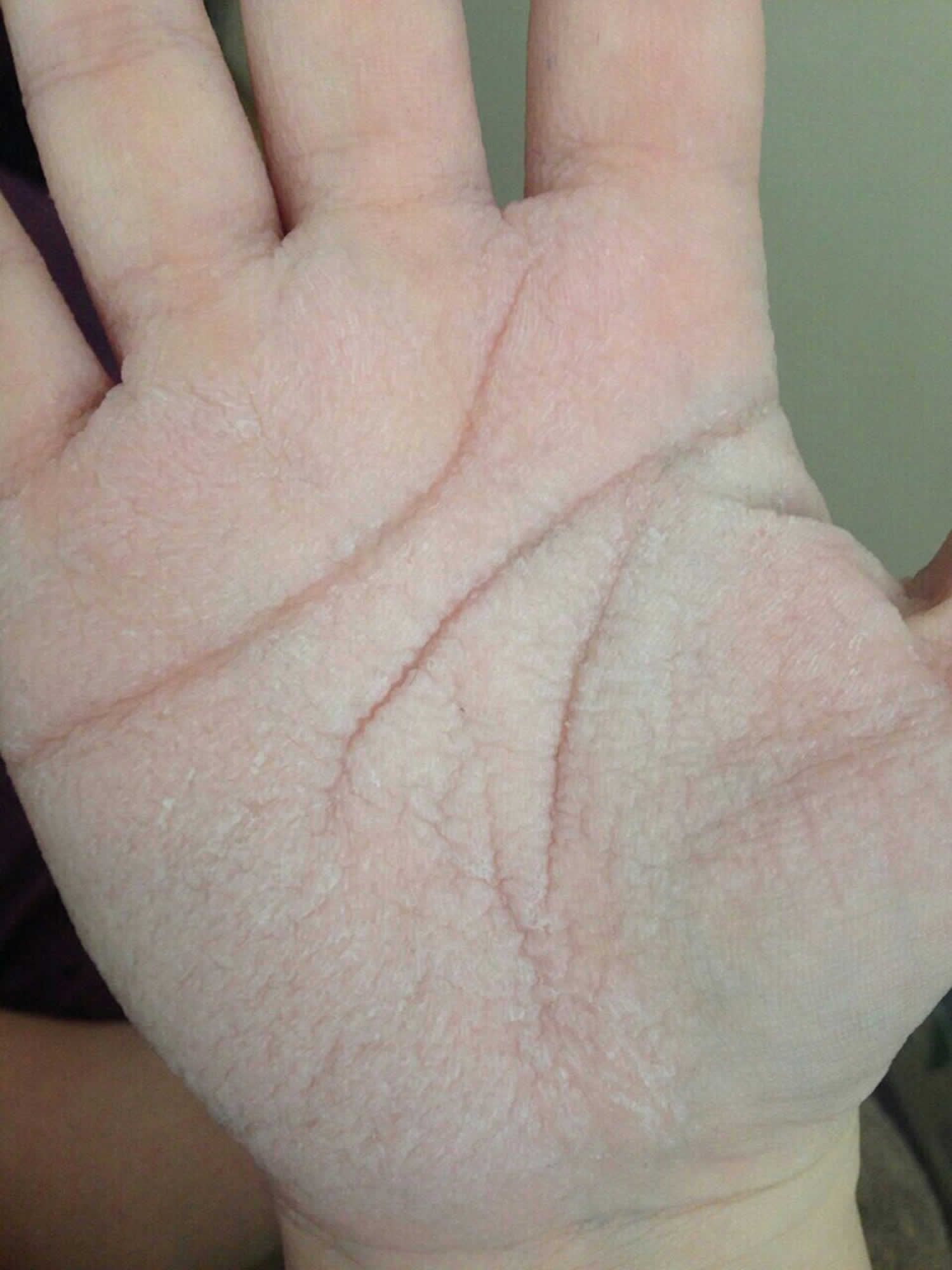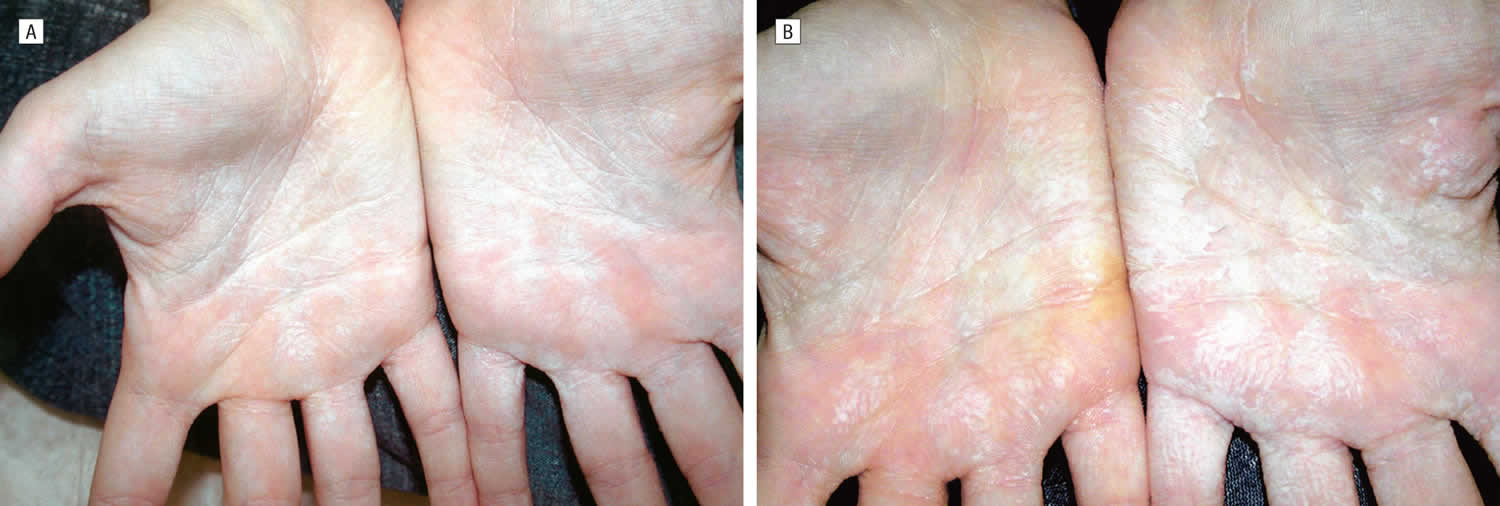Aquagenic keratoderma
Aquagenic keratoderma also known as aquagenic palmoplantar keratoderma, aquagenic syringeal keratoderma, aquagenic wrinkling of the palms, “the hand in the bucket” sign or aquagenic acrokeratoderma, is a rare acquired skin condition presenting with recurrent and transient white papules and plaques associated with a burning sensation, pain, itch and/or hyperhidrosis on the palms and more rarely, soles triggered by sweat or contact with water 1. It is an exaggeration of the normal finger wrinkling that occurs when fingers are soaked in water for a prolonged period. Often aquagenic keratoderma cause significant discomfort, thus requiring an appropriate therapy. Topical aluminum-based products are the most commonly used medications, but they are not always effective.
Aquagenic keratoderma is predominant in women with a mean age of onset of 21 years. Its cause is unknown, although about one-third of cases are associated with cystic fibrosis (CF) and some instances are induced by intake of various drugs, including aspirin, indomethacin, salazopyrin, rofecoxib and celecoxib 2. Aquagenic keratoderma may also occur in carriers of the cystic fibrosis gene. A similar disorder may arise in the setting of marasmas and nephrotic syndrome. Often aquagenic keratoderma cause significant discomfort, thus requiring an appropriate therapy 3. Topical aluminum-based products are the most commonly used medications, but they are not always effective. Other anecdotal therapies include salicylic-acid based products, formalin 3% in alcohol, antihistamines, topical corticoids, topical erythromycin, barrier agents, botulinum toxin injections and iontophoresis 4. Regarding iontophoresis, there is only one report describing its use in aquagenic keratoderma, but the results were not specified 5.
Figure 1. Aquagenic syringeal palmar keratoderma
Footnote: (A) The left hand is shown 2 minutes after immersion in tap water. The right hand was not exposed to water. (B) Close-up of the palmar surface of 1 of the digits on the left hand 2 minutes after immersion in tap water.
[Source 6 ]Figure 2. Aquagenic palmoplantar keratoderma
Footnote: (A) The palmar surfaces of the hands before immersion and 3 minutes after immersion of the left hand in tap water and the right hand in 23% hypertonic saline solution (B). Note the more dramatic response in the palm exposed to tap water.
[Source 6 ]Aquagenic syringeal palmar keratoderma causes
The cause of aquagenic syringeal acrokeratoderma or aquagenic keratoderma is still unknown, despite multiple hypotheses have been proposed including eccrine gland or nerve dysfunction, hyperhidrosis, defective stratum corneum barrier function, increased sweat salt concentration in the stratum corneum, occlusion of the eccrine duct ostia, or weakness of the eccrine duct wall 1. It may be caused by a salt imbalance in the skin cells, which results in increased water retention within these cells and increased transepidermal water loss.
Some cases have been related to medications, such as aspirin, non-steroidal anti-inflammatories and some antibiotics, and is possibly due to drug-induced dysregulation of skin aquaporin, a protein that is responsible for water transport across the cell membrane.
Aquagenic keratoderma symptoms
Aquagenic palmoplantar keratoderma or aquagenic syringeal palmar keratoderma resembles the exaggerated transient wrinkling of the palms that is caused by spending a prolonged period in a bath or pool.
It is characterized by the appearance or worsening of a palmar eruption following brief exposure to water (about 3 minutes). It takes longer to appear in mutation carriers (about 7 minutes) than in patients with cystic fibrosis (2–3 minutes). Wrinkling typically disappears within 10–60 minutes after drying, however, the eruption can persist for longer periods.
The palmar eruption is comprised of small, white or translucent papules that coalesce into plaques. The feet are unaffected. Patients may report an uncomfortable tight, burning or itchy sensation during an eruption.
Aquagenic keratoderma diagnosis
The diagnosis of aquagenic syringeal palmar keratoderma oraquagenic keratoderma is usually made on the basis of the clinical history and physical findings. The palmar eruption can usually be readily demonstrated by exposing the hands to water.
A biopsy may be taken to confirm the diagnosis.
Aquagenic keratoderma treatment
Although cases of spontaneous remission have been described 7, in most patients aquagenic keratoderma tends to persist and cause a significant physical and psychological discomfort, thus requiring an appropriate therapy. Several treatments have been reported including aluminum-based or salicylic-acid based products, formalin 3% in alcohol, antihistamines, botulinum toxin injections and iontophoresis 8.
Some patients with aquagenic syringeal palmar keratoderma have had relief with an antiperspirant such as 20% aluminium chloride hexahydrate applied to the palms at night. Other treatments include:
- Bathing in salt water
- Oral antihistamines to reduce itch
- Botulinum toxin injections
- Iontophoresis.
Iontophoresis has long been known to inhibit sweat production and therefore it is often used for the treatment of hyperhidrosis. It has been suggested that tap water iontophoresis selectively targets areas with high levels of electrolytes because of enhanced current flow. A local electro-chemical coagulation of proteins occurs in these areas and subsequently disrupts eccrine gland function. Another theory hypothesizes iontophoresis causes interrupted stimulus-secretion-coupling that leads to a functional disturbance of sweat secretion 9.
The exactly mechanisms by which iontophoresis therapy acts upon aquagenic keratoderma are unknown. It is possible to speculate that the effects of iontophoresis on aquagenic keratoderma are attributable to the reduction of sweat production and/or functional changes of eccrine gland 10.
References- Errichetti E, Piccirillo A. Aquagenic keratoderma treated with tap water iontophoresis. Indian J Dermatol. 2015;60(2):212. doi:10.4103/0019-5154.152568 https://www.ncbi.nlm.nih.gov/pmc/articles/PMC4372934
- Gündüz O, Ozsaraç KÇ, Ercin ME. Aquagenic palmar wrinkling induced by combined use of salazopyrin and indomethacin. Case Rep Dermatol. 2013;5:21–6.
- Luo DQ, Li Y, Huang YB, Wu LC, He DY. Aquagenic syringeal acrokeratoderma in an adult man: Case report and review of the literature. Clin Exp Dermatol. 2009;34:e907–9.
- Garçon-Michel N, Roguedas-Contios AM, Rault G, Le Bihan J, Ramel S, Revert K, et al. Frequency of aquagenic palmoplantar keratoderma in cystic fibrosis: A new sign of cystic fibrosis? Br J Dermatol. 2010;163:162–6.
- Lowes MA, Khaira GS, Holt D. Transient reactive papulotranslucent acrokeratoderma associated with cystic fibrosis. Australas J Dermatol. 2000;41:172–4.
- Katz KA, Yan AC, Turner ML. Aquagenic wrinkling of the palms in patients with cystic fibrosis homozygous for the delta F508 CFTR mutation. Arch Dermatol. 2005;141(5):621–624. doi:10.1001/archderm.141.5.621 https://jamanetwork.com/journals/jamadermatology/fullarticle/394464
- Coelho-Macias V, Fernandes S, Lamarão P, Assis-Pacheco F, Cardoso J. Aquagenic keratoderma associated with a mutation of the cystic fibrosis gene. Rev Port Pneumol. 2013;19:125–8.
- Houle MC, Al Dhaybi R, Benohanian A. Unilateral aquagenic keratoderma treated with botulinum toxin A. J Dermatol Case Rep. 2010;4:1–5.
- Siah TW, Hampton PJ. The effectiveness of tap water iontophoresis for palmoplantar hyperhidrosis using a Monday, Wednesday, and Friday treatment regime. Dermatol Online J. 2013;19:14.
- Errichetti E, Piccirillo A. Aquagenic keratoderma treated with tap water iontophoresis. Indian J Dermatol. 2015;60(2):212. doi:10.4103/0019-5154.152568







